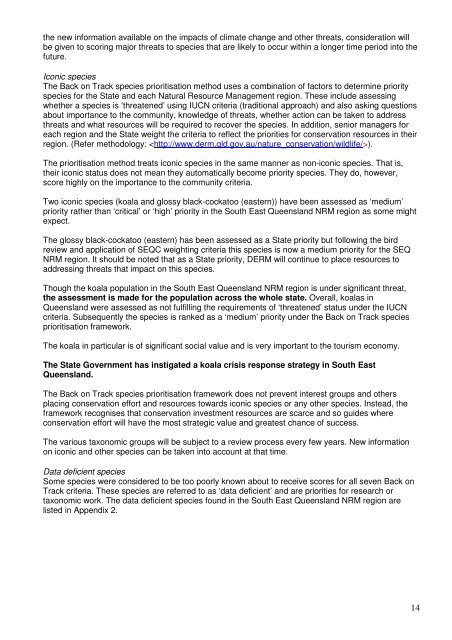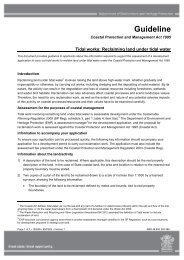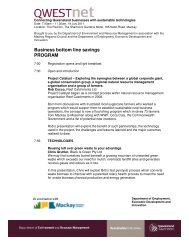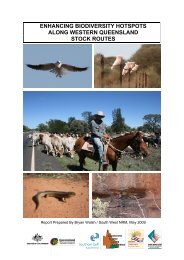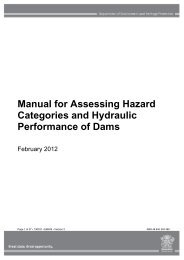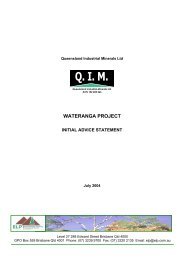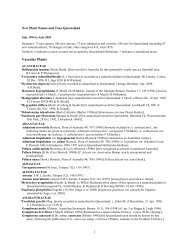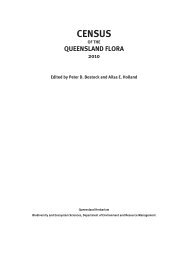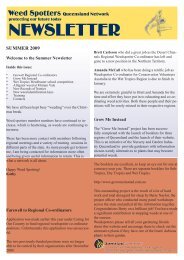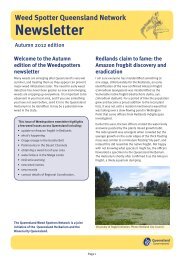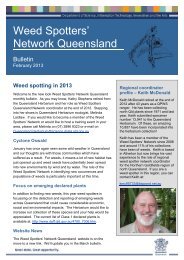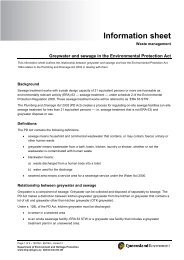Priority species - Department of Environment and Heritage Protection
Priority species - Department of Environment and Heritage Protection
Priority species - Department of Environment and Heritage Protection
Create successful ePaper yourself
Turn your PDF publications into a flip-book with our unique Google optimized e-Paper software.
the new information available on the impacts <strong>of</strong> climate change <strong>and</strong> other threats, consideration will<br />
be given to scoring major threats to <strong>species</strong> that are likely to occur within a longer time period into the<br />
future.<br />
Iconic <strong>species</strong><br />
The Back on Track <strong>species</strong> prioritisation method uses a combination <strong>of</strong> factors to determine priority<br />
<strong>species</strong> for the State <strong>and</strong> each Natural Resource Management region. These include assessing<br />
whether a <strong>species</strong> is ‘threatened’ using IUCN criteria (traditional approach) <strong>and</strong> also asking questions<br />
about importance to the community, knowledge <strong>of</strong> threats, whether action can be taken to address<br />
threats <strong>and</strong> what resources will be required to recover the <strong>species</strong>. In addition, senior managers for<br />
each region <strong>and</strong> the State weight the criteria to reflect the priorities for conservation resources in their<br />
region. (Refer methodology: ).<br />
The prioritisation method treats iconic <strong>species</strong> in the same manner as non-iconic <strong>species</strong>. That is,<br />
their iconic status does not mean they automatically become priority <strong>species</strong>. They do, however,<br />
score highly on the importance to the community criteria.<br />
Two iconic <strong>species</strong> (koala <strong>and</strong> glossy black-cockatoo (eastern)) have been assessed as ‘medium’<br />
priority rather than ‘critical’ or ‘high’ priority in the South East Queensl<strong>and</strong> NRM region as some might<br />
expect.<br />
The glossy black-cockatoo (eastern) has been assessed as a State priority but following the bird<br />
review <strong>and</strong> application <strong>of</strong> SEQC weighting criteria this <strong>species</strong> is now a medium priority for the SEQ<br />
NRM region. It should be noted that as a State priority, DERM will continue to place resources to<br />
addressing threats that impact on this <strong>species</strong>.<br />
Though the koala population in the South East Queensl<strong>and</strong> NRM region is under significant threat,<br />
the assessment is made for the population across the whole state. Overall, koalas in<br />
Queensl<strong>and</strong> were assessed as not fulfilling the requirements <strong>of</strong> ‘threatened’ status under the IUCN<br />
criteria. Subsequently the <strong>species</strong> is ranked as a ‘medium’ priority under the Back on Track <strong>species</strong><br />
prioritisation framework.<br />
The koala in particular is <strong>of</strong> significant social value <strong>and</strong> is very important to the tourism economy.<br />
The State Government has instigated a koala crisis response strategy in South East<br />
Queensl<strong>and</strong>.<br />
The Back on Track <strong>species</strong> prioritisation framework does not prevent interest groups <strong>and</strong> others<br />
placing conservation effort <strong>and</strong> resources towards iconic <strong>species</strong> or any other <strong>species</strong>. Instead, the<br />
framework recognises that conservation investment resources are scarce <strong>and</strong> so guides where<br />
conservation effort will have the most strategic value <strong>and</strong> greatest chance <strong>of</strong> success.<br />
The various taxonomic groups will be subject to a review process every few years. New information<br />
on iconic <strong>and</strong> other <strong>species</strong> can be taken into account at that time.<br />
Data deficient <strong>species</strong><br />
Some <strong>species</strong> were considered to be too poorly known about to receive scores for all seven Back on<br />
Track criteria. These <strong>species</strong> are referred to as ‘data deficient’ <strong>and</strong> are priorities for research or<br />
taxonomic work. The data deficient <strong>species</strong> found in the South East Queensl<strong>and</strong> NRM region are<br />
listed in Appendix 2.<br />
14


